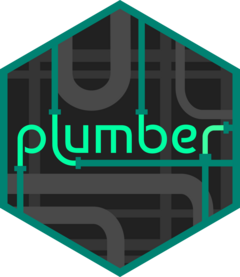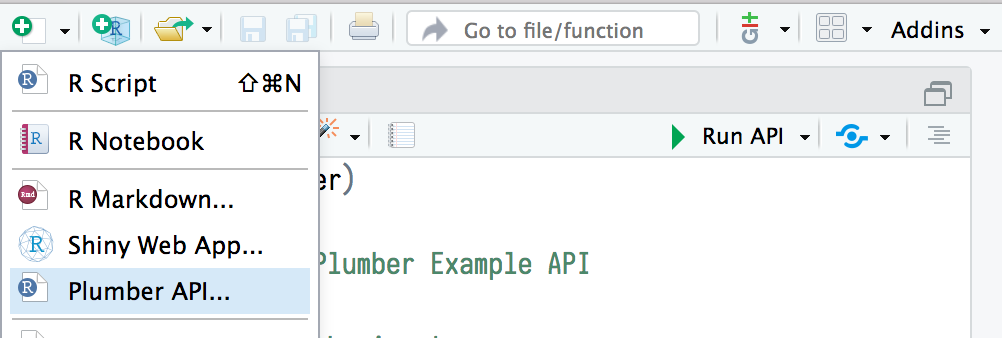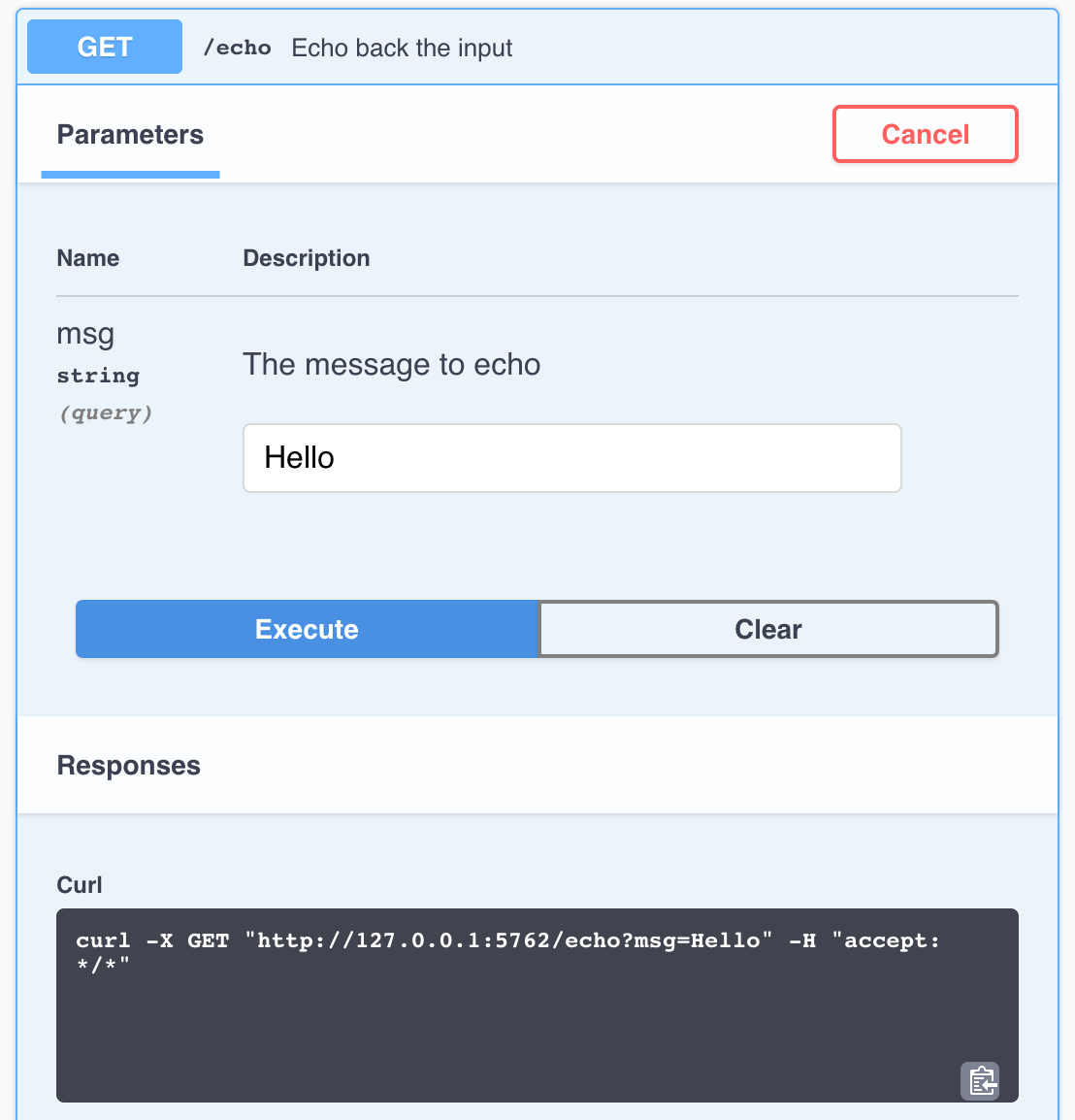
Download PDF
Web APIs use HTTP to communcation between client and server.
HTTP is built around a request and a response. A client makes a request to a server, which handles the request and provides a response. Requests and responses are specially formatted text containing details and data about the exchange between client and server.
GET / get HTTP/1.1 -> HTTP Method, Path, HTTP Version
Host:, User-Agent:, Accept: -> Headers
Request Body -> Message body
curl -v "http://httpbin.org/get"
#> GET / get HTTP/1.1
#> Host: httpbin.org
#> User-Agent: curl/7.55.1
#> Accept: */*
#
# Request BodyHTTP/1.1 200 OK -> HTTP Version, Status code, Reason phrase
Connection:, Date: -> Headers
Response Body -> Message body
Plumber uses special comments to turn any arbitrary R code into API endpoints. The example below defines a function that takes the msg argument and returns it embedded in additional text.
Plumber comments begin with #* and @ decoators define API characteristics. In HTTP methods such as @get the /<path> defines the location of the endpoint.
Plumber endpoints contain R code that is executed in response to an HTTP request. Incoming requests pass through a set of mechanisms before a response is returned to the client.
Filters: Filters can forward requests (after potentially mutating them), throw errors, or return a response without forwarding the request. Filters are defined similarly to endpoints using the @filter [name] tag. By default, filters apply to all endpoints. Endpoints can opt out of filters using the @preempt tag.
Parsers: Parsers determine how Plumber parses the incoming request body. By default Plumber parses the request body as JavaScript Object Notation (JSON). Other parsers, including custom parsers, are identified using the @parser [parser name] tag. All registered parsers can be viewed with registered_parsers().
Endpoint: Endpoints define the R code that is executed in response to incoming requests. These endpoints correspond to HTTP methods and respond to incoming requests that match the defined method.
Methods
@get - request a resource@post - send data in body@put - store/update data@delete - delete resource@head - no request body@options - describe options@patch - partial changes@use - use all methodsSerializer: Serializers determine how Plumber returns results to the client. By default Plumber serializes the R object returned into JavaScript Object Notation (JSON). Other serializers, including custom serializers, are identified using the @serializer [serializer name] tag. All registered serializers can be viewed with registered_serializers().
Identify as filter with @filter, filter name is log, and forward request with forward():
Define the endpoint description, opt out of the log filter, define the parser, HTTP method and endpoint path, and serializer:
Plumber APIs can be run programmatically from within an R session.
This runs the API on the host machine supported by the current R session.

Plumber APIs automatically generate an OpenAPI specification file. This specification file can be interpreted to generate a dynamic user-interface for the API. The default interface is generated via Swagger

Once the API is running, it can be interacted with using any HTTP client. Note that using httr requires using a separate R session from the one serving the API.
Plumber is exceptionally customizable. In addition to using special comments to create APIs, APIs can be created entirely programatically. This exposes additional features and functionality. Plumber has a convenient “tidy” interface that allows API routers to be built piece by piece. The following example is part of a standard plumber.R file.
Use the @plumber tag, create a function that accepts and modifies a plumber router (pr), and use “tidy functions” like pr_get() and pr_post() for buildings out Plumber API.
library(plumber)
#* @plumber
function(pr) {
pr |>
pr_get(path = "/echo",
handler = function(msg = "") {
list(msg = paste0(
"The message is: '",
msg,
"'")
)
}) |>
pr_get(path = "/plot",
handler = function() {
rand <- rnorm(100)
hist(rand)
},
serializer = serializer_png()) |>
pr_post(path = "/sum",
handler = function(a, b) {
as.numeric(a) + as.numeric(b)
})
}Plumber automatically creates an OpenAPI specification file based on Plumber componenets. This file can be further modified using pr_set_api_spec() with either a function that modifies the existing specification or a path to a .yaml or .json specification file.
library(plumber)
#* @param msg The message to echo
#* @get /echo
function(msg = "") {
list(
msg = paste0("The messahe is: '", msg, "'")
)
}
#* @plumber
function(pr) {
pr |>
pr_set_api_spec(
function(spec) {
spec$paths[["echo"]]$get$summary <- "Echo back the input"
spec # Return the updated specification
}
)
}By default, Swagger is used to interpret the OpenAPI specification file and generate the user interface for the API. Other interpreters can be used to adjust the look and feel of the user interface via pr_set_docs().
Plumber provides access to special req and res objects that can be passed to Plumber functions. These objects provide access to the request submitted by the client and the response that will be sent to the client. Each object has several components, the most helpful of which are outlined below:
Request Objects
| Name | Example | Description |
|---|---|---|
req$pr |
plumber::pr() |
The Plumber router processing the request |
req$body |
list(a = 1) |
Typically the same as argsBody |
req$argsBody |
list(a = 1) |
The parsed body output |
req$argsPath |
list(c = 3) |
The values of the path arguments |
req$argsQuery |
list(e = 5) |
The parsed output from req$QUERY_STRING |
req$cookies |
list(cook = "a") |
A list of cookies |
req$REQUEST_METHOD |
"GET" |
The method used for the HTTP request |
req$PATH_INFO |
"/" |
The path of the incoming HTTP request |
req$HTTP_* |
"HTTP_USER_AGENT" |
All of the HTTP headers sent with the request |
req$bodyRaw |
charToRaw("a = 1") |
The raw() contents of the request body |
Response Objects
| Name | Example | Description |
|---|---|---|
res$headers |
list(header = "abc") |
HTTP headers to include in the response |
res$setHeader() |
setHeader("foo", "bar") |
Sets an HTTP header |
res$setCookie() |
setCookie("foo", "bar") |
Sets an HTTP cookie on the client |
res$removeCookie() |
removeCookie("foo") |
Removes an HTTP cooki4 |
res$body |
"{\"a\":[1]}" |
Serialized output |
res$status |
200 |
The response HTTP status code |
res$toResponse() |
toResponse() |
A list of status, headers, and body |
Plumber supports asynchronous execution via the future R package. This pattern allows Plumber to concurrently process multiple requests.
Plumber routers can be combined by mounting routers into other routers. This can be beneficial when building routers that involve several different endpoints and you want to break each component out into a separate router. These separate routers can even be separate files loaded using plumb().
In the above example, the final route is /bar/foo.
Some packages, like the Plumber package itself, may include example Plumber APIs. Available APIs can be viewed using available_apis(). These example APIs can be run with plumb_api() combined with pr_run().
Once Plumber APIs have been developed, they often need to be deployed somewhere to be useful. Plumber APIs can be deployed in a variety of different ways. One of the easiest way to deploy Plumber APIs is using Posit Connect, which supports push button publishing from the RStudio IDE.
CC BY SA Posit Software, PBC • info@posit.co • posit.co
Learn more at rplumber.io.
Updated: 2024-05.